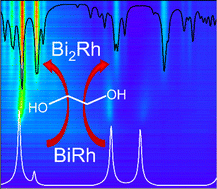In situ investigation of the formation mechanism of α-Bi2Rh nanoparticles in polyol reductions†
Abstract
The synthesis of intermetallic phases formed from elements with very different melting points is often time and energy consuming, and in extreme cases the evaporation of a reactant may even prevent formation completely. An alternative, facile synthesis approach is the reduction of metal salts in the polyol process, which requires only moderate temperatures and short reaction times. In addition, the starting materials for this procedure are readily available and do not require any special treatment to remove or prevent passivation layers, for example. Although the formation of intermetallic particles via the polyol process is an established method, little attention has been paid to the mechanism behind it. However, it is precisely a deeper understanding of the underlying mechanisms that would enable better and more targeted synthesis planning and product design. Taking the well-known formation of Bi2Rh particles from Bi(NO3)3 and various rhodium salts in ethylene glycol as an example, we studied the chemical process in detail. We investigated the effects of anion type and pH on the polyol reaction. The reaction was also probed by in situ X-ray diffraction using synchrotron radiation. Products, intermediates and solutions were characterized by X-ray and electron diffraction, electron microscopy and optical spectroscopy. In the first step, co-reduction of the metal cations leads to BiRh. Only with increasing reaction temperature, the remaining bismuth cations in the solution are reduced and incorporated into the BiRh particles, leading to a gradual transition from BiRh to α-Bi2Rh.



 Please wait while we load your content...
Please wait while we load your content...